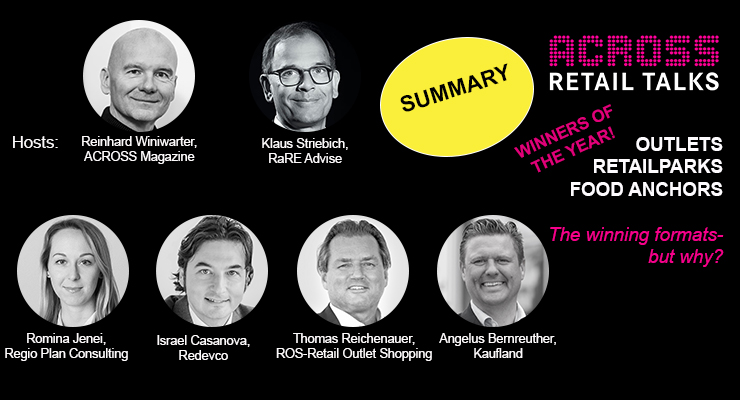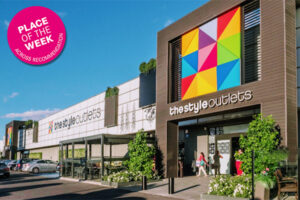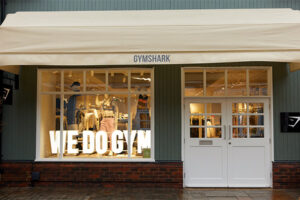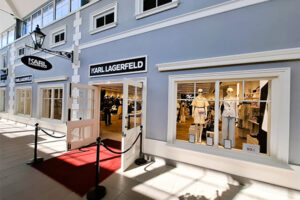The moderator of the ACROSS Retail Talk is Klaus Striebich (RaRE Advise).
The discussants of this episode are:
- Angelus Bernreuther, Head Of Investor Relations at Kaufland
- Israel Casanova, Fund Director Retail Warehouse Parks at Redevco
- Romina Jenei, CEO Regio Plan Consulting
- Thomas Reichenauer, Co-Founder and MD of ROS Retail Outlet Shopping
Customers´ views, habits, and their impact on the success of retail real estate portfolios
Romina Jenei: The main topic among customers is insecurity – customers want a secure network, and, consequently, they are more selective about the locations. On the one hand, convenience is key – locations for local supply need to be combined with other daily tasks of the customers. On the other hand, customers want formats that they know, e.g., outlet center discounts/reduced prices. There is a dichotomy of local supply and experience shopping, which includes emotions, entertainment, etc. If you are not on one side or the other, it´s challenging to attract the customer.”
Convenience, safety, and security versus new experience in shopping
Angelus Bernreuther thinks that “safety, security, convenience and experience are a perfect match. We should differentiate a bit between daily needs (food anchor stores) and experience shopping (shopping centers). Instead of “facing uncertainty,” food retailers are facing frequent shop visits, and trying to make it simple for the customer is key so as not to waste time.” For example, Kaufland tries to implement a one-stop shopping/“all-encompassing” daily goods shopping experience for customers. Bernreuther emphasizes, “Ensure the experience, yes, on the one hand. Conversely, you have to make it simple for the customer.”
Thomas Reichenauer agrees: “Giving a clear message to customers is key during times of uncertainty. What is currently a great advantage is great designer and premium brands at great locations built up during the years. Also, outlet centers know what they can expect, e.g. it is clear what the USP and footfall of the outlet center is. This also needs to be tailored to customers´ needs. There is no “one-size-fits-all” approach. It is essential to give customers a good feeling. This is currently one of the advantages of outlet centers. Still, a future challenge for the industry is to keep it high-quality by breaking it up into different premium experiences and not get vague by not delivering the exact advantages that the format promises.
Elaborating from the perspective of retail park operators, Israel Casanova shares a similar opinion with the other panelists: “Value for money should be offered – that is what retail parks are about. Retail parks also have to provide experience and diversification; adding to the traditional retail mix, other uses for the customer, such as F&B, can be seen frequently these days. Remaining flexible is most important to adapt to complex issues during these challenging times. One-stop for everything is a viable concept that will be increasingly widespread, especially in urban areas, since customers nowadays are very much constrained when it comes to their time. However, sustainability, and social responsibility that aligns with customers´ values in these assets are also important.”
Customers´ 2-3 key drivers for choosing the winning formats
From Bernreuther´s viewpoint, “Kaufland as a food operator operates in rural and urban areas. People come to Kaufland because food retailing is the top driver behind retail footfall. The bigger the town and competition, the more the food retailer has to ensure that it lives from its actual catchment area. But when it comes to more synergies in retail parks, it´s not only the retailer´s synergy in terms of footfall that should be valued but all the customers´ synergies. Synergy also derives from customers´ needs being satisfied, and considering aspects, such as time-saving, which is crucial in gastronomy. Satisfaction of customer needs and time-saving is primary for a retail location.
The future of outlet center locations – Key drivers to make these locations more vibrant
Reichenauer explains that “well-managed outlets are already quite attractive at the moment. Another topic is tourism – tourists coming back to the center is key. Also, you have to have a clear outlet strategy (each brand with one store, attractive brand mix), and last but not least a wow-effect for the customer when you provide new offers, stores, etc. “We must keep the innovation ongoing with constant new ideas. Key is optimism and a proactive, forward-thinking approach”.
Retail parks combined with outlet centers?
Casanova: “Creating new experiences is vital, but both require different management, and the fundamentals like location, easy access to parking, faster check-out, and omnichannel embracing service must also be considered. The combination with outlet with its premium brands performs very well in certain cases, as outlet centers focus on premium brands, while the retail parks focus on discounts.”
Are mixed-use developments the No. 1 winner format of Retail Real Estate?
Jenei says, “Definitely, mixed-use is another word for creating urbanity. While the concept itself is quite old, parts of the mix in mixed-use are new concepts, such as senior living, or medical centers. Moreover, ground-floor retail areas are very important in mixed-use properties, but the aspects of work-, and living environment should also be suitably addressed.”
Bernreuther adds: “One thing across Europe is true, reuse and revitalization of retail assets will be one of the key drivers of the future. The more urban the area, the more mixed-use assets will be combined. The more rural the area, the more reuse of retail purpose will be in the forefront.”
E-commerce and outlet centers
Reichenauer: “It´s important to integrate digitalization into all the marketing and communication channels, but classical outlets cannot truly compete with really online traders, such as Amazon, since outlets do not have the logistics, and products are not in their hands.”
ESG in retail assets, retail parks – How would the social part of ESG be implemented?
Bernreuther states, “We should not only focus on “E” topics. Yes, “E” has the most impact in terms of saving CO2, and is measurable – “S” in ESG is, on the other hand, more adaptive and can be measured from case to case, so there is no “one-size-fits-all.” As an operator, you must see yourself as part of the city landscape by interacting with the people and customers. That is why you must adapt to the needs and have more social impact with your operations.”
Technology integration and locality
As Jenei explains, “Local retailers in smaller municipalities help to create USPs. They help to differentiate. You have to differentiate by bringing variety into your offer when you are not a local supplier. That is what locality can do. E-commerce is also a key factor for everyone. Similarly to mixed-use, grocery anchors are also winners, but we should not generalize, as grocery anchors don´t have a high online share yet, just as not all food anchors are among the winning formats.”
Reichenauer adds to Jenei´s statement: “People – you have to have the right, motivated people, and employer branding is crucial. Offering free buses to your co-workers, and organizing customer programs helps you connect with the community and colleagues you work with. What is the best way to bring customers to the store? As an example, not overloading customers with information is important. There are many approaches. However, there is no clear-cut strategy. Everybody is testing out different things.”
Health and wellness at retail parks
Casanova states, “Retail parks can cater to health and wellness-oriented consumers, so it makes sense to add them to the retail offering of properties.”
You can watch the uncut version of the latest ACROSS Retail Talks here:
We have more exciting discussions in our pipeline so follow us on social media to never miss the next ACROSS Retail Talks!







